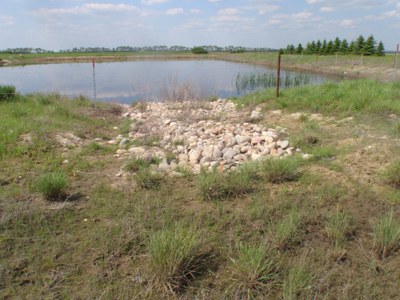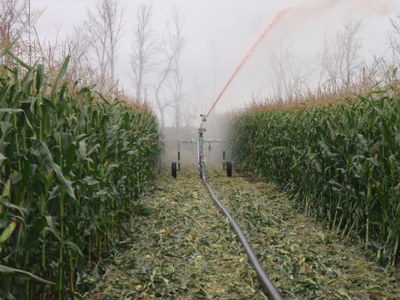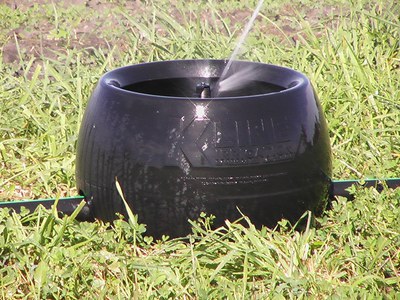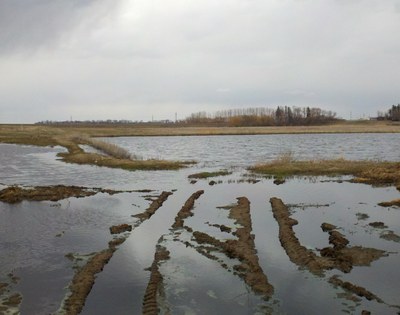Containment Pond Management (NM1626, Revised Oct. 2019)

Figure 1. An animal feeding operation containment pond
Photo by Chris Augustin
Containment ponds are constructed at the base of a feedlot’s slope and designed to collect and contain nutrient-loaded runoff (Figure 1). Ponds are designed to hold water for at least 270 days, plus the 24-hour, 25-year rain event with an additional foot of freeboard (North Dakota Department of Environmental Quality, 2018).
Containment pond effluent levels are designed to be reduced through evaporation. However, during wet years, precipitation can be greater than evaporation. This leads to a situation in which pond drawdown is required before it overflows.
Monitoring pond levels and land-applying effluent before a pond is full prevents the containment pond from overfilling. Irrigation systems such as a traveling gun (Figure 2) or a moveable sprinkler system (Figure 3) work well to apply containment pond effluent.
Containment pond management needs to be a proactive measure taken before an issue develops. A full containment pond may discharge its water, causing polluted water to enter a downslope water body. A discharge event may erode pond banks and require extensive and expensive dirt work to repair.
Routinely check the containment pond, water diversions and other earthen structures for structural soundness and any signs of erosional damage or seepage. Also, record containment pond levels. For more information on containment pond depth markers, consult the NDSU Extension publication “Liquid Level or Depth Marker for Earthen Runoff Ponds,” NM1514.
If a discharge occurs, you must call the North Dakota Department of Environmental Quality at 701-328-5210 during normal working hours or the Division of Emergency Services at 800-773-3259 during non-working hours (including weekends and holidays) within 24 hours of the discharge.
For more information on containment pond discharge management, consult the NDSU Extension publication “Manure Spills: What You Need to Know and Environmental Consequences,” NM1555.
Applying pond effluent on soil is more than spraying water on land. Consider soil infiltration rates and crop nutrient requirements when land-applying containment pond effluent. Section 7.6.3 of the North Dakota Livestock Program Design Manual (North Dakota Department of Environmental Quality, 2018) states, “When irrigating with manure or process wastewater, the application rate shall not exceed the estimated soil infiltration rate, or the nutrient requirements of the crop. Irrigation application rates shall be adjusted to avoid significant ponding of manure or process waste water in surface depressions or seasonal drainage ways.”
Soil and Water Relationships
The soil infiltration rate is determined by soil texture, topography and soil water content. Water will infiltrate finely textured soils, such as clay, more slowly than coarsely textured soils (Table 1). Soil compaction from field equipment traffic or naturally occurring high-sodium soil horizons can lower soil infiltration rates. Water infiltration is fast on dry soil but slows as the soil becomes saturated.
Table 1. Water infiltration rate of differing soil texture classes.

Figure 2. Applying containment pond effluent on a cornfield with a traveling gun
Photo by Chris Augustin

Figure 3. A moveable sprinkler irrigation system applying containment pond effluent.
Photo courtesy of E.J. Habrock, K-Line Irrigation North America
Slopes affect soil infiltration rates because of runoff. Steep slopes increase runoff, whereas shallow slopes lessen runoff. Depressed areas create ponding, allowing more time for water infiltration. Nutrient management experts recommend applying effluent on slopes less than 6%.
Use caution when applying containment pond effluent near surface waters. The effluent cannot be applied closer than 100 feet to a down-gradient surface water, open-tile line intake structures or well heads. Barren-soil fields are more prone to runoff than fields with vegetation or residue. Applying effluent on areas where buffer strips, standing crops or forage are present greatly reduces the chance for runoff.
Soil texture also predominately determines the amount of water a soil can hold. Even though water infiltrates faster into a sandy soil than a clayey soil, the sandy soil will hold less water than the clayey soil (Table 2). This is because the clayey soil has more pore space than the sandy soil.
Table 2. Water-holding capacities of differing soil textures.
Applying Effluent for Crop Needs
The effluent must be applied to meet crop nutrient needs. Small amounts of nutrients can be found in containment pond effluent (Table 3). Testing effluent for nutrients is important to ensure that nutrients are not overapplied. Excess nitrogen and phosphorus in surface water can cause algae blooms and lower water quality. However, excess potassium in surface water does not lead to algae blooms. For more information on sampling containment pond effluent for nutrients, consult the NDSU Extension publication “Manure Sampling for Nutrient Management Planning,” NM1259.
Table 3. Average amount of nutrients from 12 containment ponds in Barnes County, N.D.
When to Apply Containment Pond Effluent
Manage containment ponds before a problem occurs. The best time to manage a containment pond is during the summer, when evaporation is greatest and soils tend to be the driest.
However, high pond levels are most likely to occur during the spring snow thaw, when finding a suitable application site can be difficult (Figure 4). Saturated soils are common, which can increase runoff risks. If effluent needs to be applied during the spring on wet soils, it should be applied as thinly and on as many acres as possible.

Figure 4. A full containment pond shortly after a spring thaw
Photo by Chris Augustin
Containment Pond Effluent Application Example
Here is an example of how to determine the amount of effluent to apply to a field:
A 700-head feedlot has an area of 9.6 acres. The animal feeding operation is in central North Dakota. It receives 17.5 inches of annual precipitation, and the 25-year, 24-hour rainfall is 3.9 inches. To meet regulations, the containment pond is designed to hold 2,098,510 gallons of water.
The containment pond has reached the must-pump mark on the depth pond marker and contains approximately 1,924,000 gallons of effluent. The producer plans to apply 1,904,000 gallons of effluent on 40 acres of forage. The soil is a loam with an infiltration rate of 0.5 inch per hour and a water holding capacity of 2.3 inches per foot. One acre-inch of water is equal to 27,154 gallons of water.
In this example, the application will be 70 acre-inches of containment pond effluent on 40 acres of forage at 1.75 inches per acre and the application will take 140 hours. Using the nutrient levels from Table 3, 8 pounds of nitrogen per acre and 143 pounds of potassium per acre will be applied. This application should not oversaturate the soil, cause a runoff issue or create a nutrient loading issue.
Summary
Proper containment pond management is an important piece in a nutrient management plan. Utilizing effluent water as an irrigation source is a good use that also lowers containment pond levels. Traveling guns and sprinkler irrigation systems are ways to apply containment pond effluent. Do not apply effluent at a greater rate than a soil’s infiltration rate and in areas that are prone to runoff.
References
North Dakota Department of Environmental Quality. 2018. North Dakota livestock program design manual. https://deq.nd.gov/WQ/2_NDPDES_Permits/1_AFO_CAFO/AC.aspx. North Dakota Department of Environmental Quality, Bismarck, N.D.
Rawls, W.J., D.L. Brakensick and K.E. Saxton. 1982. Estimation of soil properties. Transactions of the American Society of Agricultural Engineers, 25:1316-1320.
Scherer, T.F., B. Seelig and D. Franzen. 1996. Soil, water, and plant characteristics important to irrigation. North Dakota State University Extension, Fargo, N.D.

